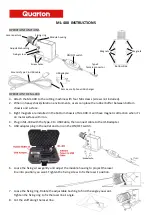
21
Tel: 886.909 602 109 Email: [email protected]
S3101A/B provides two measurement formats including DTF return loss and DTF VSWR. As for their difference, we will not explain
here again for it is similar to the difference between return loss and VSWR. We will make a detailed introduction for measurement
steps on cable length and return loss at each point, through taking the cable with length of 25m, velocity factor of 0.76 and cable loss
of 0.26dB/m.
1. Press
【
Meas
】
to enter the measurement menu;
2. Select [DTF Return Loss] menu to set the current measurement format to “DTF Return Loss”.
3. Press
【
Freq
】
to enter the frequency menu; select [Start Freq] menu, then use the numeric keys, knob or arrow keys to input
the start frequency value and select the corresponding unit menu to complete the input; the frequency in this example is set to
1GHz.
4. Similar to step 3, set the stop frequency needed by the measurement; the frequency in this example is set to 2GHz.
5. Press
【
Sweep
】
to enter Sweep menu; select [Point] to set the required sweep point, which is set to 401 here.
6. Select [Start Distance] menu, input appropriate measurement start distance by the numeric keys, knob or arrow keys, and then
select the unit menu [Meter] to finish the setting.
7. Similar to step 6, set the measurement stop distance. Once the test points and frequency are set, the current maximal test
distance of Analyzer is determined (it is displayed in the lower left corner of the screen) too. Users can adjust stop distance
based on this value and estimated position of measured fault points. If the current maximum distance is less than the
measurement distance, sweep span and points can be properly adjusted. Detailed explanation can be found in “DTF
Measurement Distance & Resolution” part in Section 3.5 of this chapter.
8. According to Section 3.1 in this Chapter, calibrate port 1 of Analyzer;
9. Press
【
Freq
】
->[Velo Factor] to set velocity factor of DUT, which is the transmission speed and light speed of electromagnetic
wave in the cable, is between 0-1.
10. Select [Cable Loss] menu, and set cable loss of the measured cable according to the known parameters of DUT.
Velocity factor and cable loss are inherent parameters of cable, if any further questions, please check the cable instructions or
consult the cable manufacturer.
11. DTF return loss curve can be measured and obtained by connecting DUT to Analyzer and then link the mismatch load or open
circuit to the end of the cable (as fault point). DTF return loss test connection is as shown in Figure 3.10.










































